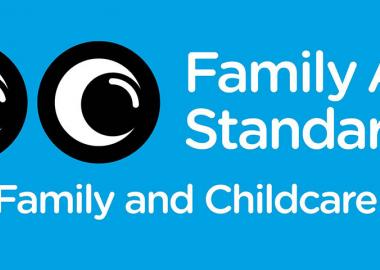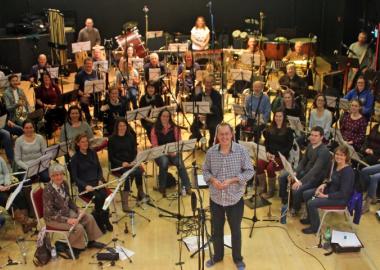Collaborations between music groups can be hugely beneficial and a lot of fun for everyone involved. They are exciting projects with lots of challenges and opportunities that can take the enjoyment of being in, and running, a music group to the next level.
Contents:
- The benefits of collaboration
- Key considerations
- Getting started - the big picture: when, where, what and how
- In-depth planning and logistics
- As the performance approaches
- Afterwards
1. The benefits of collaboration
Try something new or different:
- Larger scale performances become more viable – giving your members the chance to perform in front of bigger audiences and in venues they might not usually get to perform in
- You can tackle repertoire you might not otherwise get to perform, and add variety to your programming
- The challenge of working with another group is very rewarding in itself
- The chance to sing, play and socialise with a new group of people
Learn:
- New music and new skills – maybe learn a new style of music or work in a new way with a different conductor or MD
- Share best practice and find out how other groups operate
Grow:
- Expose your group to new audiences and expand your mailing list
- A chance to undertake some simple market research and develop new marketing strategies
- Increase your potential: making your group more attractive to members, audiences and funders
2. Key considerations
In many respects planning a joint event is not necessarily that different to planning a normal performance: many of the aspects of planning are the same, but of course you have to do it all with another group. We think there are a few key considerations to get right early on to help make it an enjoyable and successful event.
Decide on your type of collaboration
Collaborations can take different forms. It might be that one group is taking the lead and inviting another group to perform with them, or maybe both groups are starting from scratch and planning everything together. All types of collaboration can work and the planning will vary for each one. The important thing is that everyone understands the nature of the agreement and is comfortable with their role.
This guidance will focus more on projects that are joint ventures where both groups have an equal investment and role - but parts of it will still be applicable to other types of collaborations.
A genuinely joint project
If you are taking the joint venture approach it is important that both groups feel like equal partners with a shared vision from the outset. This can help reduce the chances of creative differences further down the line.
Thinking and talking about the bigger picture in the very early stages will help with this. Make sure both groups are going into the project for the same reasons and with the same expectations.
- Where did the original idea for this come from and why do you want to do it?
- What are the musical aims?
- What do you want your members as individuals, the group in general and your audiences to get from it?
- Is there enthusiasm from the group members for the project?
There are also some practical things you can do to make it a project of equals:
- Consider the distribution of work - if this is even, it will make it a more collaborative experience – and stop one of the parties feeling hard done by!
- Ensure equal billing in publicity for all those involved
- Find some neutral ground: Meeting and rehearsing on neutral ground can help create parity, but if this is difficult in practical terms just swapping between who hosts each time will help.
Relationships
You will be working with people you not have worked with before so it is worth taking some time to get to know each other. The better these relationships are, the better the project will go. A social occasion before or after a meeting or rehearsal can help kick things off on the right foot.
- Music Directors – it’s important that all MDs are on board with the project and are happy with the repertoire, the musical approach and their role in the project. A guest director can be a good option too – it can give members a new experience and can help make the project feel different and special.
- Project management group – these are the people that will be doing the most of the work: the better they understand each other the smoother it will be.
- Group members – cliques and tensions won’t make for a happy camp. Find time for all members to get to know each other.
Be aware of differences
All groups operate differently so compromise and flexibility are a must. You may pay professionals different amounts or handle tickets sales differently, for example. Nothing should be a problem but the sooner you think about and identify potential areas of difference the easier they will be to overcome.
This can be especially true when vocal and instrumental groups collaborate. They may have different musical and practical (e.g. space for instrument storage) considerations that everyone needs to be aware of.
Keep in mind the above point about shared ownership: if areas of difference are always settled by doing it the way Group A does it then the project can lose some of its collaborative feel.
3. Getting started - the big picture: when, where, what and how
Having a general ‘big picture’ discussion at the very start will help you get your aims clear, ensuring both groups have shared goals and are singing from the same hymn sheet. It will also make turning the idea into a detailed plan of action easier.
When - set the date
It can be a good idea to set a date early, as it gives you a focus and helps build momentum. Consider:
- What works best for the schedules of all groups involved – do you have existing commitments that you need to work around?
- How many performances do you want to do – joint events can make multiple performances more viable.
- What time of year will the performance(s) be – will there be any major events or holidays that could affect attendance?
Where - choose a venue
A joint event may require a bigger venue than normal, or you might want to book somewhere different simply to celebrate the new partnership. You should consider all the usual things when selecting a venue, but be aware of size – there will be more performers and audience members than at your normal events. Consider:
- Space for audience size – including interval refreshments (preparation and sale)
- Space for performers – for actual performance and a suitable ‘green room’ area for performers (will you need more than one?)
- Access points and space to load and unload
What - choose your repertoire
The repertoire will often be a key motivator for collaborating with another group, so you may already have an idea of what you want to perform – but consider all the options available to you.
- A larger group of performers gives you more options - try to make it a special occasion for your potential audience, offering them something different that they may not be able to hear elsewhere.
- Make sure that the repertoire is appropriate to the forces available and the performance standards of all groups involved – so that all performers are fairly represented and have an equal chance to shine.
- Consider the availability and cost of the music you want to perform – it would be a shame to plan a huge event only to discover later that the music is impossible to get hold of or prohibitively expensive.
How - think about finances
Take a big picture overview of the finances in the first instance.
- Where will the money come from?
- Are you likely to be able to raise enough from combined ticket sales to cover the total costs?
- Will you hold joint fundraising events or seek joint sponsorship?
- Will you pursue some outside funding towards the project? (Remember that this is not guaranteed income at this stage, so have a back-up plan!)
- What are the main costs that need to be covered? (Venue hire, music hire, marketing, professional fees)
- Will all costs and income be split 50/50? If not, how will they be split?
There is no need to have a detailed budget at this stage. A general idea of costs and how you will fund the event so you have some idea of viability should be fine.
4. In-depth planning and logistics
Once you are all agreed on the bigger picture for your collaboration, it’s time to get down to the detailed planning and consider all aspects of the project in depth. Planning efficiently and well ahead will help to ensure the success of your project.
Project management team
Setting up a team consisting of 2 or 3 people from each group is a good way to manage the project and ensure everything is on track. This should be small enough to work more efficiently and get things done but also big enough to share the load. You can always ask other people who are not on the team to help if you do need extra pairs of hands.
It is also a good idea to have a main contact for each group to oversee the project and work with each other outside of team meetings.
Collaboration agreement
A simple collaboration agreement to set down the aims of the project and make clear the responsibilities can really help sharpen the focus on your initial plan. It does not have to be a long legal agreement that goes into every minute detail of what needs to be done and how. The project team will find ways of working, but a collaboration agreement can provide a framework for the project.
Have a look at our advice on creating a collaboration agreement.
Detailed timetable
There can be lots of people involved so having a clear timetable of when things need to happen with realistic but firm deadlines for each element of the collaboration is important. Make sure all key people have a copy and that they are kept informed of any changes.
Fully itemised realistic budget
All good events need a well-planned and realistic budget:
- Be clear about what your combined groups can afford/are prepared to pay and make sure both groups are comfortable with the arrangements.
- Be clear about who is responsible for managing the budget and who can actually spend the money, and build in regular review points for both groups to monitor costs.
- Include a contingency plan too: what happens if you do need to put in more money than you originally anticipated? How will each group contribute if extra funds are required?
Insurance
Public Liability cover: if both groups have public liability cover then both policies can be active for a joint event. Venues normally ask to see the public liability cover of whoever is making the booking – and claims will be made against whoever entered into the contract with the venue. If you would like both groups’ policies to be in place then your contract with the venue should specify that it is a joint event and list both groups’ names - and both groups should present their public liability information to the venue too.
When it comes to how claims might be handled; every claim is different so we cannot give specific guidance, but generally speaking if both groups have a public liability cover in place and it is hard to determine responsibility and liability the claim could be split between the two groups. If one group is held liable then the claim could be made against their policy.
Cancellation cover: If both groups have cancellation cover then both groups would be covered, within the terms of their policy, for any irrecoverable expenses they have incurred towards the event
If one only group has cancellation cover they would be covered, within the terms of their policy, for any irrecoverable expenses they have incurred towards the event. It would not cover any money paid by the other group towards the event. There is nothing to stop the groups agreeing that any payment made to the group with cancellation cover will be split between the two groups – any such agreement should be detailed in a collaboration agreement.
Rehearsal logistics
Once you have confirmed your date, venue and repertoire you can start to plan your rehearsal schedule. Work backwards from your performance date to ensure that enough time is allowed for everything to be learned and rehearsed. Some things to consider:
- How many joint rehearsals do you need and where will they be?
- Will each group be expected to reach a certain point musically before each joint rehearsal?
- Which MDs will take which rehearsals? Do both need to be present?
- If there are new techniques to be learned, have you incorporated enough rehearsal time for learning these?
- Will each group host some rehearsals at their normal venue – if so will it be big enough?
- Who will provide refreshments during joint rehearsals? You may need a longer break to accommodate more people.
- Will you need break out rooms for sectionals, or group work?
- Try and include time and space for socialising with each other.
Scores/sheet music
The key question here is will each group be responsible for getting their own or will one person coordinate it for both groups?
- If each group is responsible for their own then make sure both groups are working from the same edition. You will also need to decide who is responsible for getting scores for accompanists where appropriate.
- If one person is responsible for both groups then you need to be clear on numbers and parts (e.g. do you need more string parts than normal?). You also need to agree on a system for signing out and collecting the music.
In either case your MDs/conductors will need to find time to agree on and copy any markings for the parts so that all performers receive the same information about amendments, cuts, changes and rehearsal points.
Professional fees (if applicable)
You may need a greater number of professionals than usual in order to make the collaboration a success. Each group may also have pay different rates and use different contracts/terms and conditions. Agree on how this will work before engaging any professionals.
Marketing
Groups will have their own usual plans for promoting their events. There is likely to be some cross over between these, so developing a joint marketing plan is a good idea. It will ensure you are maximising your resources and not duplicating work, and that promotional material and messaging is consistent.
- What is the hook for this event? Agree early on what the key message of your marketing is. What would someone with no prior knowledge of any of the groups involved find attractive about this event?
- If you are producing printed material, who takes responsibility for commissioning and approving the design?
- Agree on use of brand colours (maybe a new natural colour could work for a joint event), logos and billing.
- Consider quantities and agree how they will be distributed in your local community – there is no point in both groups covering the same ground.
- Agree on wordings for press releases and articles and who to send them to.
- Agree on your social media plan.
- Will each group agree to do a certain number of posts?
- Will you always tag each other in posts, and who else do you need to tag – MDs, funders, sponsors?
- Try and agree a rough schedule so both groups aren’t always posting on the same day.
As it’s a joint event there may be other ways you could try to promote it. There might be some interest from local media organisations and publications. Maybe you could do a discount/bulk booking scheme for organisations in the local area such as schools or workplaces.
Box office
- Will groups sell their own tickets? Or perhaps you will use the venue or an online ticketing site.
- If groups are selling their own tickets make sure they know how many tickets they have allocated to them. If seats can be reserved make sure they are allocated fairly.
- If the groups normally use different online sites pick one of them: spreading sales across two sites can lead to difficulties.
- However you do it, it is important someone is in charge of managing and coordinating box office and keeping everyone updated on numbers.
5. As the performance approaches
Presentation
Presentation is extremely important and yet is often left until the last minute. What you normally wear for performances may well be fine, but bring it up early on to avoid unfortunate clashes - like an orchestra in pink and a choir in orange! If changes are made it can be good to try and preserve a bit of each group’s identity and style.
Consider how you will get your performers on and off the stage and how you will manage any choreography between pieces, given the greater number of people involved. Do you need to implement a new or different system to manage this? Do you need to create a seating plan?
It is likely the usual things will go in the concert programme – but decide early on who will take responsibility for collating it and make sure each group is happy with, and has checked, any copy about themselves and their MDs. Also consider dividing the content equally between the groups so that each makes an equal contribution.
Front of house management and volunteers
Share your resources for front of house management and recruit volunteers from all groups involved.
- Decide which roles and how many volunteers are needed – and which group will recruit for which role.
- If you have regular volunteers their usual way of working may need to change. The set up may be different, the venue may be unfamiliar and the audience may be greater. Be prepared to give them support and help them adapt to the circumstances, and inform them as early as possible of any expected changes to your normal procedures.
- Consider recruiting more volunteers than you usually would, to ensure that everything runs smoothly on the night.
6. Afterwards
Hopefully your collaboration has been successful and you all have some wonderful memories of the event. Your collaboration doesn’t stop when the event is over though:
- Have a de-brief session to tie up any loose ends, finalise the accounts and write any funding reports if required.
- Review the event and consider what went well and what needed some work.
- What would you do differently next time?
- Have you learned anything new either musically or administratively
- How can you put what you have learned into practice in future?
- Why not organise a joint social/celebration event for your groups to mark the end of the collaboration in style and allow your members to keep up with their new friends?
- Think ahead – could you collaborate again, if so when and what will your next project be?
Top 5 takeaways
1. Collaboration means a bigger audience, a bigger venue and possibly a more ambitious piece of music!
2. Make it clear how you will be collaborating, who will be taking the lead or will it be joint
3. Sort out the practicalities with the other group, ie when, where, soloists
4. Decide how you will divide the cost and income
5. Discuss who will take on what role in advertising the event, manning the box office, serving drinks, etc.
Use our guidance to create a group collaboration agreement, or see what other groups have learnt with our collaboration case study.
We hope you find this Making Music resource useful. If you have any comments or suggestions about the guidance please contact us. Whilst every effort is made to ensure that the content of this guidance is accurate and up to date, Making Music do not warrant, nor accept any liability or responsibility for the completeness or accuracy of the content, or for any loss which may arise from reliance on the information contained in it.










